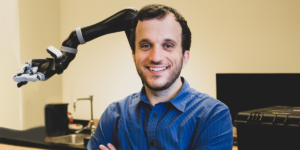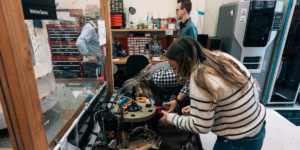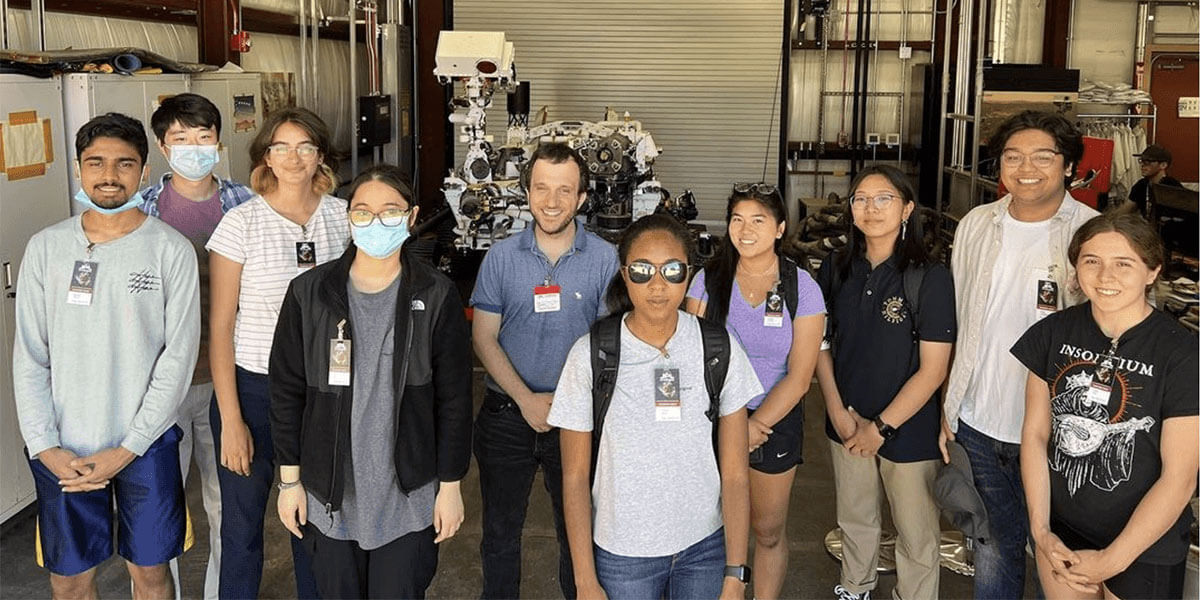
This summer, visiting students participating in the USC Viterbi Robotics and Autonomous Systems REU Program visited NASA JPL with Stefanos Nikolaidis, an assistant professor in computer science (center).
When Aditi Haiman, a computer science junior at Columbia University, took a music theory class last year, something stood out to her.
“Sitting down at a piano, it’s hard to come up with something that’s original and not influenced by music you’ve already heard,” Haiman said. “As far as I know, there isn’t a way to compose music by just interacting with your environment.”
It also underscored her feeling that music composition is often inaccessible and intimidating for beginners or people with physical limitations.
“As far as I know, there isn’t a way to compose music by just interacting with your environment.” Aditi Haiman
So, this summer at USC, when Haiman took part in the USC Viterbi Robotics and Autonomous Systems Research Experiences for Undergraduates (REU) Program, she developed Music Cube, a cube-shaped device that plays different notes when rotated, based on its orientation in 3D space.
The cube “knows” what side is facing up because of a mechanism called a tilt switch—a small, loose metal ball rolling around inside—that touches the sides of the cube as it moves. Once the ball makes contact with a side, the circuits light up signaling that the cube is oriented in a way that corresponds with a note.
In future iterations, Haiman, who has played classical piano for more than a decade, plans to replace the tilt switch with a gyroscope for better accuracy, an accelerometer and WiFi capabilities so that the cube can connect to composing software on a computer.
The device is simple to create and use, making music composition accessible for people who can’t read or write sheet music or people who have difficulty with fine motor skills.
“It’s also a great way to bring in younger kids to get involved with music,” said Haiman.
Driving their own projects
Haiman was one of 8 students who took part in the summer program, aimed at under-represented groups in engineering, where undergraduates learn and experiment with robotics using state-of-the-art equipment.
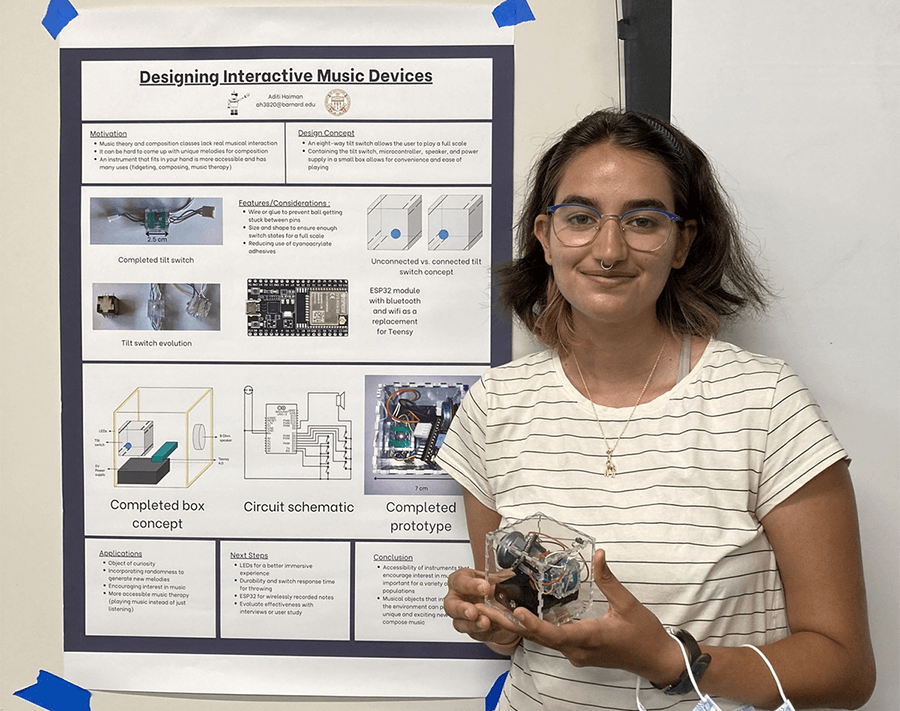
Aditi holds the prototype of the Music Cube next to the schematics for the project that she presented as part of the program.
The USC REU site, led by Stefanos Nikolaidis, an assistant professor of computer science, brings undergraduate students to Los Angeles to drive their own projects and research cutting-edge technology in a wide breadth of robotic applications, from machine learning and scientific discovery to healthcare and helping at-risk populations.
“The goal of the program is to increase students’ enthusiasm in robotics and computer science,” Nikolaidis said. “We want to strengthen their interests in studying these fields in graduate school.”
Using the labs, training, and faculty mentorship provided by the program, students created prototypes exploring everything from robotic social assistants to vehicles that can automatically navigate around obstacles. They also attended world-leading research centers and laboratories, including the NASA Jet Propulsion Laboratory.
A helping hand
Paolo Limcaoco, a mechanical engineering junior from Boston University, joined a project with other students called the CAM Smart Robotic Assistant. Their prototype shows how a simple mechanical arm and camera can tidy up workspaces or hand out tools, so that humans can busy themselves with more complex tasks.
“Some tasks are better situated for humans and some are better situated for robots—a person could do the cleaning up, but their time might be better spent doing something else,” Limcaoco said. “If you can make robots that are able to do some of the work that humans would usually do, it makes workspaces more efficient.”
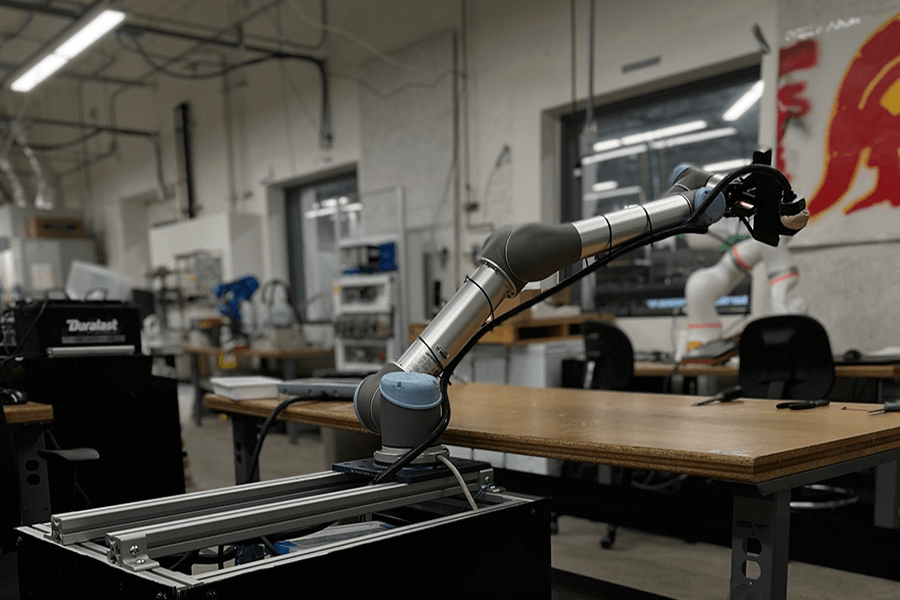
The CAM Smart Robotic Assistant was designed to safely hand tools and items to humans using a gripper that can change shape depending on what it’s holding.
Limcaoco’s contribution was the gripper “hand” of the robot, called the Parallel Panular Gripper (PPG), which can pick up a variety of objects without breaking or dropping them.
The gripper consists of malleable fingers filled with a grainy material that uses an interior vacuum to harden itself and make a perfect mold of the object being held. Compared to the rudimentary grip you would find on many other robots, which simply applies pressure, Limcaoco’s design is safer and less likely to break the tools.
The resources offered by the program were essential to the project, according to Limcaoco, especially the workspace at USC’s Center for Advanced Manufacturing. The equipment was dedicated to student use and readily available, and his cohorts in the program were a welcome source of support throughout his stay.
“If I needed materials or help in general, there were other graduate researchers I could reach out to,” said Limcaoco. “On top of that, I had access to these industrial-grade 3D printers in the same room as my workspace—I didn’t have to wait the typical few days for my parts to get printed.”
Indeed, equipping students for a future in robotics research is one of the key aims of the program, according to Nikolaidis.
“Through the REU program, we’re trying to imbue students, particularly from underrepresented groups with a sense that they can succeed in research,” Nikolaidis said. “We want to show that it’s not a career for ‘someone else.’”
Published on October 7th, 2022
Last updated on October 7th, 2022





